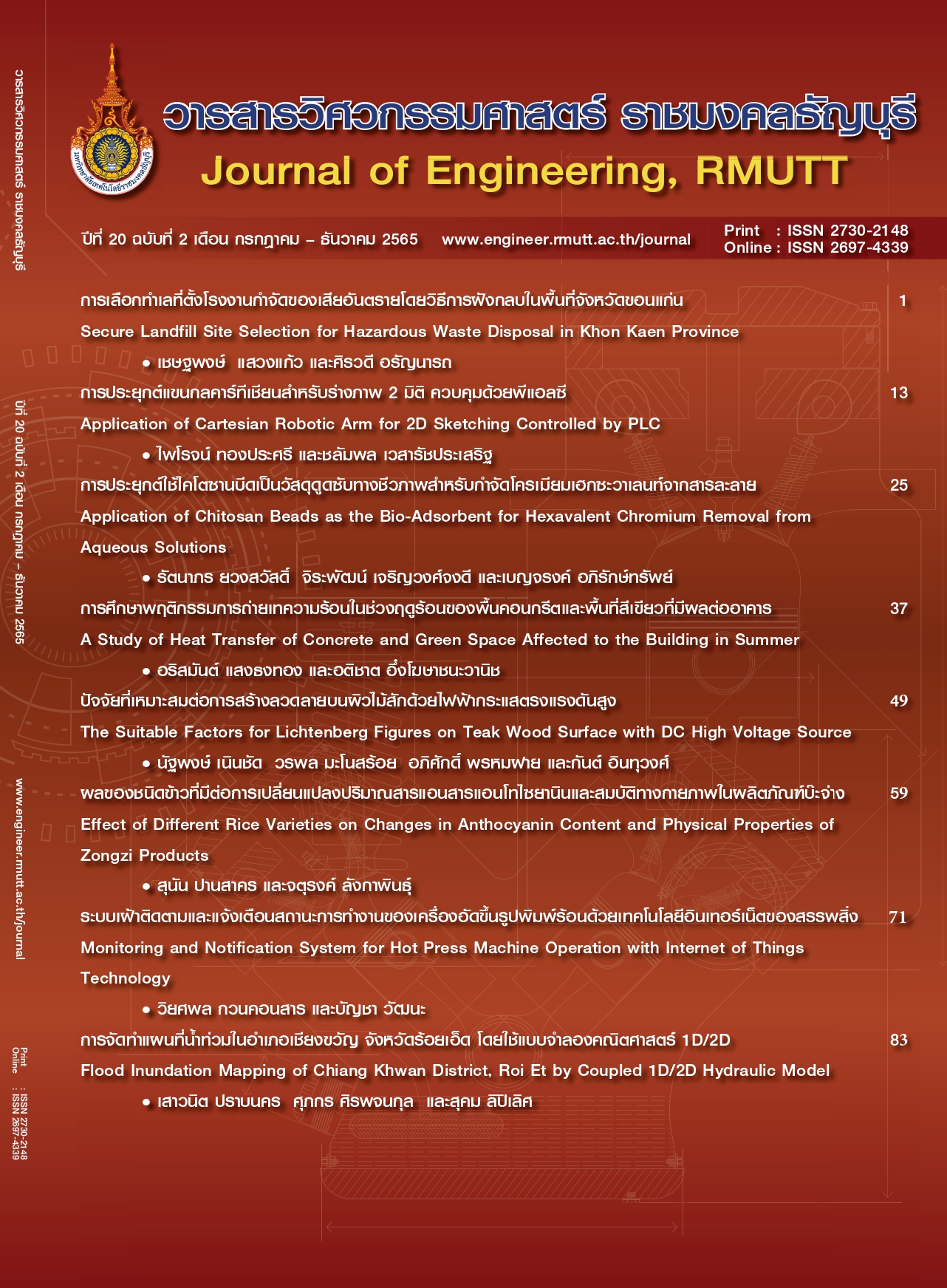Application of Cartesian Robotic Arm for 2D Sketching Controlled by PLC
Main Article Content
Abstract
This paper presents the application of a cartesian robotic arm for 2D sketching, width 297 mm, length 400 mm. The movement of the x and y axis is linear, which is driven by servo motor. To reduce cost, the z-axis movement of the robotic arm uses an electric solenoid instead of a servo motor. The movement of all 3 axes of the robotic arm is controlled by PLC model CJ2M-CPU11. The defined coordinates or positions for moving the robotic arm are obtained by converting the black and white image prototype using the ALL TO G-Code Converter program. The coordinate data cannot be directly imported into the PLC's memory. A program to adjust the coordinates for storing in PLC's memory was developed on MATLAB program. This program can shrink or enlarge the coordinates from the prototype image. The PI type feedback control is used to control the speed of the servo motor. The prototype image used must not exceed 100 Kbyte in size. If the line is thick, the positions obtained by converting with ALL TO G-Code Converter program are only the border of the prototype image. The experimental results, the cartesian robotic arm can sketch the fastest according to the defined image prototype. The speed setting of the x and y axis servo motor must be related to the proportion of the prototype. Optimal values for acceleration and deceleration, Kp, and Ti are 50c/s2, 800 Hz and 1600 ms, respectively. Since the z axis movement of the robotic arm uses an electric solenoid. The circular sketch according to the prototype looks distorted. Sketching equipment, the head of pen must be strong enough because the z-axis cannot control the pressure.
Article Details

This work is licensed under a Creative Commons Attribution-NonCommercial-NoDerivatives 4.0 International License.
The manuscript, information, content, picture and so forth which were published on Frontiers in engineering innovation research has been a copyright of this journal only. There is not allow anyone or any organize to duplicate all content or some document for unethical publication.
References
Shrivakshan G.T. A Comparison of various Edge Detection Techniques used in Image Processing. Int. Journal of Com-puter Science. Sep 2012;9(5):269-76.
Yakovlev S.G. Software development for 3d visualization of g-code when working with CNC machines. Journal of Physics: Conf. Series. 2020:1-6.
Munna M.S, Tarafder B.K, Robbani Md.G, Mallick T.C. Design and implementa-tion of a drawbot using MATLAB and ardiuno mega. Int. Conf. on Electrical, Computer and Communication Engineering. 2017: 769-73.
Baid P, Kumar M.V. A 3 – DOF robot arm for drawing application. Int. Journal of Engineering Research & Technology. 2016;4(26):1-4.
Calinon S, Epiney J, Billard A. A humanoid robot drawing human portraits. Inter. Conf. on Humanoid Robots. 2005: 1-6.
Tresset P, Leymarie F.F. Portrait drawing by paul the robot. Article in Computers & Graphics. Aug. 2013;1-33.
Pichkalev M, Lavrenov R, Safin R, Hsia K.H. Face drawing by KUKA 6 axis robot manipulator. Developments in eSystems Engineering. 2019:709-714.
Rata M, Rata G. Application with a XY-plotter controlled by PLC used in student laboratory works. Inter. Sym. on Advanced Topics in Electrical Engineering. 2015:1-4.
Mishra S.K, Jha S, Sri R.G, Yashaswini N. Arduino based computer numerical control plotter. Inter. Res. Journal of Engineering and Technology. June 2021;8(6):2413-16.
Saha J, Niphadkar T, Majumdar Arpan. Drawbot: A mobile robot for image scanning and scaled printing. Inter. Journal of Mechanical Engineering and Robotics Research. 2016;5(2):124-28.
Xu S., Anwer N., Lavernhe S. Conversion of G-code programs for milling into STEP-NC. Proc. of Joint Conference on Mechanical, Design Engineering. 2014:1-7.


